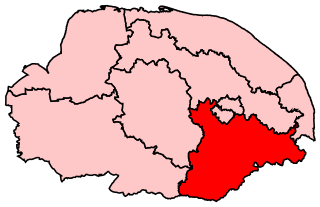Related Research Articles
Over the history of the House of Commons, the number of Members of Parliament (MPs) has varied for assorted reasons, with increases in recent years due to increases in the population of the United Kingdom. There are currently 650 constituencies, each sending one MP to the House of Commons, corresponding to approximately one for every 92,000 people, or one for every 68,000 parliamentary electors.

North Essex was a parliamentary constituency represented in the House of Commons of the Parliament of the United Kingdom between 1997 and 2010. It elected one Member of Parliament (MP) by the first past the post system of election.

South Norfolk is a constituency represented in the House of Commons of the UK Parliament since 2001 by Richard Bacon, a Conservative.

Chelmsford is a constituency in Essex represented in the House of Commons of the UK Parliament since 2017 by Vicky Ford of the Conservative Party. In September 2022, she was appointed by Prime Minister Liz Truss as Minister of State for Development in the Foreign, Commonwealth and Development Office.

Maldon is a constituency in Essex represented in the House of Commons of the UK Parliament since 2010 by Sir John Whittingdale, a Conservative.

Epping was a parliamentary constituency represented in the House of Commons of the UK Parliament from 1885 to 1974. It elected one Member of Parliament (MP) by the first past the post system of election.

Stockton-on-Tees is a former borough constituency represented in the House of Commons of the Parliament of the United Kingdom. It elected one Member of Parliament (MP) by the first past the post system of election from 1868 to 1983.
South Essex was a county constituency represented in the House of Commons of the Parliament of the United Kingdom from 1832 to 1885. It elected two Members of Parliament (MPs) using the bloc vote system.
East Cheshire was a parliamentary constituency which returned two Members of Parliament (MPs) to the House of Commons of the Parliament of the United Kingdom. Elections were held using the bloc vote system.
Hackney was a two-seat constituency in the House of Commons of the UK Parliament created under the Representation of the People Act, 1867 from the former northern parishes of the Tower Hamlets constituency and abolished under the Redistribution of Seats Act, 1885.

East Norfolk was a constituency in the county of Norfolk that returned two members of parliament to the House of Commons of the Parliament of the United Kingdom from 1832 until 1868. It was re-established in 1885 with representation of one member. That seat was abolished in 1950.
North East Lancashire was a county constituency of the House of Commons of the Parliament of the United Kingdom. The constituency was created by the Reform Act of 1867 and replaced the North Lancashire Parliamentary constituency, a county division with two seats.
Northern West Riding of Yorkshire was a parliamentary constituency covering part of the historic West Riding of Yorkshire. It returned two Members of Parliament (MPs) to the House of Commons of the Parliament of the United Kingdom, elected by the bloc vote system.
Eastern West Riding of Yorkshire was a parliamentary constituency covering part of the historic West Riding of Yorkshire. It returned two Members of Parliament (MPs) to the House of Commons of the Parliament of the United Kingdom, elected by the bloc vote system.
Southern West Riding of Yorkshire was a parliamentary constituency covering part of the historic West Riding of Yorkshire. It returned two Members of Parliament (MPs) to the House of Commons of the Parliament of the United Kingdom, elected by the bloc vote system.

South Durham, formally the Southern Division of Durham and often referred to as Durham Southern, was a county constituency of the House of Commons of the Parliament of the United Kingdom. It elected two Members of Parliament (MPs) by the bloc vote system of election.
Stamford was a constituency in the county of Lincolnshire of the House of Commons for the Parliament of England to 1706 then of the Parliament of Great Britain from 1707 to 1800 and of the Parliament of the United Kingdom from 1801 to 1918. It was represented by two Members of Parliament until 1868 when this was reduced to one.
EastEssex, formally known as the East Division of Essex was a parliamentary constituency in the English county of Essex. From 1868 to 1885, it returned two Members of Parliament (MPs) to the House of Commons of the Parliament of the United Kingdom, using the bloc vote system of election.
The county of Northumberland has returned four MPs to the UK Parliament since 1983. Under the Local Government Act 1972, which came into effect on 1 April 1974, the boundaries of the historic/administrative county were significantly altered with the south-east of the county, comprising more than half the electorate, being transferred to the new metropolitan county of Tyne and Wear. These changes were reflected in the following redistribution of parliamentary seats which did not come into effect until the 1983 general election, resulting in a reduction in the county's representation from 10 to 4 MPs.
References
- ↑ "Boundary Commission Report 1868". Vision of Britain. Retrieved 10 February 2018.
- ↑ "Boundary Commission Report 1832". Vision of Britain. Retrieved 10 February 2018.
- ↑ "Representation of the People Act 1867" (PDF). Retrieved 27 July 2017.
- ↑ "A Collection of the Public General Statutes: 1867/68. Cap. XLVI. An Act to settle and describe the Limits of certain Boroughs and the Divisions of certain Counties in England and Wales, in so far as respects the Election of Members to serve in Parliament". London: Eyre and Spottiswoode. 1868. pp. 119–166. Retrieved 23 May 2020.
- ↑ "HMSO Boundary Commission Report 1868, Essex".
- 1 2 3 4 Craig, F. W. S. (1989) [1977]. British parliamentary election results 1832–1885 (2nd ed.). Chichester: Parliamentary Research Services. p. 388. ISBN 0-900178-26-4.